
What is an ROV?

Mohawk ROV in Flower Garden Banks National Marine Sanctuary
Remotely operated vehicles, known as ROVs, are unmanned robots that are controlled with remote hardware, usually by an operator at the ocean’s surface. Think of them as remote-controlled robotic submarines that venture down to places in the ocean humans cannot or should not visit.
Used for underwater research, exploration, and discovery, ROVs are connected to a ship at the ocean’s surface by a group of long cables that transmit information back and forth between the machine and its operators. They often have mechanical arms for moving objects out of the way and collecting biological or geological samples. They also have high-definition video cameras for navigation and recording, and a number of sensors to collect information about their physical environment like water temperature, salinity, and pressure. They come in many shapes and sizes depending on their function and are important tools for exploration science.
The purpose of ROVs can vary greatly including exploring difficult-to-navigate underwater caves, studying animals that would otherwise be disturbed by the presence of divers, collecting information about the seafloor, and traveling to depths that would be impossible for us to reach in a way that is cheaper and more efficient than sending an occupied-submersible.
The National Marine Sanctuary Foundation is dedicated to supporting exploration and discovery in the ocean and of course in America’s national marine sanctuaries. Some Foundation-funded projects that use ROVs include:
Purchasing of the Mohawk ROV: The Foundation supported the partial purchase of a ROV umbilical cord for the Mohawk ROV, an essential tool in underwater research diving deeper for longer periods than afforded by traditional diver surveys. The data it collects are useful in Flower Garden Banks National Marine Sanctuary management decisions addressing the expansion of sanctuary boundaries; protection of resources including essential fish habitat and expansion of protected biological zones; biological habitat zonation and modeling; habitat characterization; and locating marine debris.
Habitat Characterization of the Northwestern Gulf of Mexico – ROV Support: The Flower Garden Banks National Marine Sanctuary partnered with NOAA’s Deep Coral Research and Technology Program to conduct two ROV cruises during the field season of 2018. The National Marine Sanctuary Foundation’s Mohawk ROV was utilized for the work.
Gray’s Reef Southeast Regional MATE ROV Competition: Each year the Gray’s Reef National Marine Sanctuary Foundation sponsors an out-of-classroom STEM learning opportunity for teachers and their students to build model ROVs that operate like those used by NOAA and other organizations to conduct ocean research. Teams compete for the right to represent their region in the Marine Advanced Technology Education (MATE) International ROV Competition. Each summer the MATE Center hosts an international competition for teams at advanced and intermediate levels. Due to the continued spread of COVID-19, all 2020 MATE ROV Competitions have been cancelled. The health and safety of its participants are most important.
